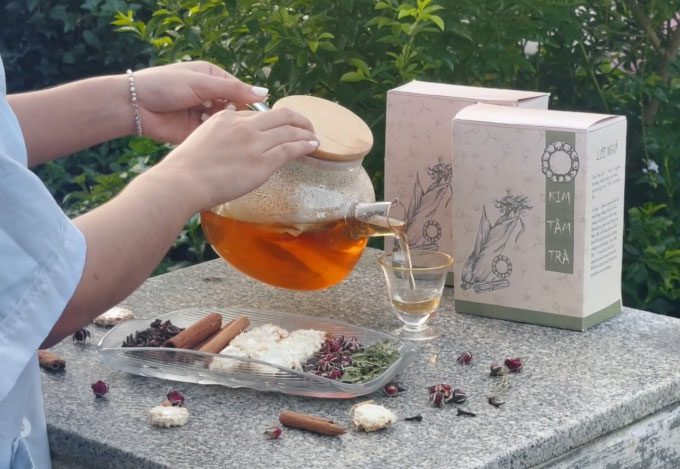Student Group from Duy Tan University (Da Nang) Utilizes Corn Cobs to Create Nutritional Tea.
A research project conducted by five students: Nguyen Hoang Nhat Thang, Pham Thi Thanh Tam, Son Hoang Phu Qui, Doan Van Dinh Nguyen, and Nguyen Tran Nhat Linh from the Faculty of Environment and Natural Sciences at Duy Tan University lasted approximately six months.
Pham Thi Thanh Tam, a representative of the group, mentioned that corn is the second most widely grown crop in Vietnam after rice. A large quantity of corn cobs is not reused after processing and is disposed of in the environment. In some areas, corn cobs are used as animal feed or mushroom growing substrates, but at a low value.
Research has shown that corn cobs contain many beneficial health compounds such as anthocyanins, beta-sitosterol, saponins, tannins, and other polyphenolic compounds. Among these, the anthocyanin content in corn cobs is considered higher than that in the kernels. This compound has antioxidant properties that provide numerous health benefits, including improving cardiovascular function and preventing diabetes. Beta-sitosterol helps control cholesterol levels, reduces cancer cell activity, and boosts immunity. The research group has developed tea bags using these compounds extracted from corn cobs.

Tea made from corn cobs by the Duy Tan University research group. (Photo: NVCC).
To extract the tea, corn cobs are cleaned and then dried at 70 degrees Celsius for three hours. The dried product is then ground and sifted to a size of about 0.5 – 1 mm, suitable for tea bags. The material is then blended with various additives such as cloves, stevia, cinnamon, and rose petals, with a ratio of 90% corn cobs and the remaining ingredients making up the rest. The mixed material is then packaged into tea bags.
According to Nguyen Hoang Nhat Thang, the process of mixing ingredients is considered the most important and time-consuming step, requiring multiple ratios to find the flavor that suits Vietnamese tastes. Thang noted that adding too much cinnamon can create a strong flavor that overpowers other aromas, while too much stevia can make the tea harsh, preventing drinkers from appreciating the sweet aftertaste of the corn cobs.
Regarding color, the team had to mix ingredients to achieve the characteristic yellow color of the tea. “The group conducted dozens of experiments to find the most suitable color and flavor”, Thang stated. After many experiments, the tea has the typical yellow color of corn cobs, and the brew is free of sediment. The tea has a light sweet taste and a harmonious aroma from the ingredients.
According to Le Thi Thanh Tam, during the tea production process, the group has not yet evaluated the corn cobs for potential heavy metal residues from soil and water sources. The group plans to seek raw material areas that meet cleanliness and safety standards in the future.
The tea made from corn cobs is aimed at individuals aged 20 to 50, as this group is often at higher risk for obesity due to unhealthy eating and lifestyle habits. The light sweet flavor of the tea is easy to drink and helps reduce bad cholesterol levels in the blood.

Group members introducing the corn cob tea product at the post-harvest processing technology competition held in Ho Chi Minh City on November 23. (Photo: Ha An).
Master Pham Thi Nga, a lecturer at the Faculty of Environment and Natural Sciences at Duy Tan University, assessed that utilizing corn cobs to make tea is not only beneficial for health but also an environmentally friendly idea by using agricultural by-products that would otherwise be wasted. By utilizing this inexpensive raw material, the group’s tea bags have significant commercialization potential at an affordable price, suitable for most consumers. However, according to Master Nga, the group needs to evaluate the antioxidant capabilities of the compounds in corn cobs. Additionally, the group must research safe preservatives to extend the shelf life of the tea bags to meet future business requirements.


















































